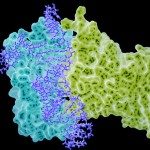Lien vers Pubmed [PMID] – 18028943
J. Mol. Biol. 2007 Dec;374(4):917-24
The lack of understanding of amyloid fibril formation at the molecular level is a major obstacle in devising strategies to interfere with the pathologies linked to peptide or protein aggregation. In particular, little is known on the role of intermediates and fibril elongation pathways as well as their dependence on the intrinsic tendency of a polypeptide chain to self-assembly by beta-sheet formation (beta-aggregation propensity). Here, coarse-grained simulations of an amphipathic polypeptide show that a decrease in the beta-aggregation propensity results in a larger heterogeneity of elongation pathways, despite the essentially identical structure of the final fibril. Protofibrillar intermediates that are thinner, shorter and less structured than the final fibril accumulate along some of these pathways. Moreover, the templated formation of an additional protofilament on the lateral surface of a protofibril is sometimes observed as a collective transition. Conversely, for a polypeptide model with a high beta-aggregation propensity, elongation proceeds without protofibrillar intermediates. Therefore, changes in intrinsic beta-aggregation propensity modulate the relative accessibility of parallel routes of aggregation.

